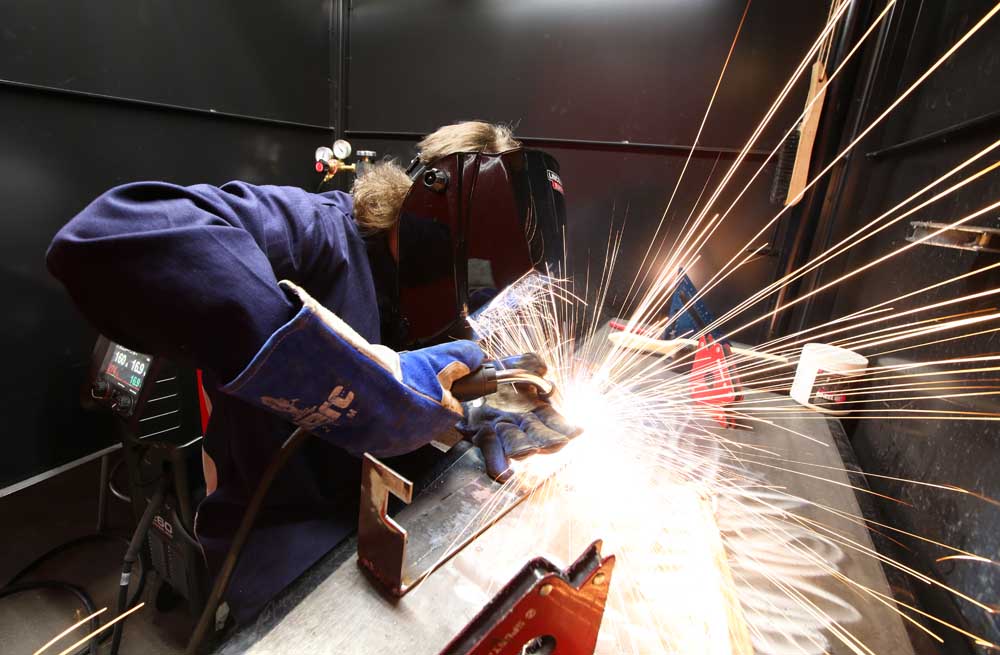Proposed levy would help popular career, technical education programs at Bend-La Pine Schools
Published 5:45 am Wednesday, May 8, 2024

- Sparks fly as Caldera High junior Parker Green welds a clamp storage system he’s creating in a career and technical education program at the Bed school Monday morning.
A group of students stood around a propane tank in Caldera High School’s career and technical education maker space, a workshop full of tools and equipment that included welding booths and cutting machines. They were working on a project to test fuel efficiency.
The maker space is large, fitting for an engineering program that includes welding, machining and design, among other disciplines. But welding isn’t its own program, despite it being in constant demand, said teacher Ben Iverson.
“I have students come up to me, especially with the metals, and ask ‘we have a welding program now?’ And I have to kind of explain that it’s a maker space. It has a welding component, so that means it could grow in the future,” said Iverson. “There is the demand for it.”
Career and technical education is thriving in Bend-La Pine Schools, but may have to be cut back if voters do not approve the district’s local option levy in the May 21 primary election, the district said. The levy, a property tax of $1 per $1,000 of assessed value for five years, is expected raise $21 million in the first year. The district estimates the levy would increase property taxes by more than 3%. The owner of a home with an assessed value of $238,750 would pay $239 a year, according to election documents submitted by the school district.
The state Legislature funded Oregon schools for the 2021-23 school years at a 3.3% increase from the previous two years, which was lower than expected. Federal pandemic relief funds were used to fill in the gap, but those funds are ending in September. The district doesn’t have enough funding to meet its current needs.
If the levy doesn’t pass, the district will have to cut staff positions, though some will be cut through resignations and retirements. If the levy passes, the funding ensures the district can hire more people, keep programs running and even expand.
“There’s been a large shift the last 10 years or so to recognize the importance of these programs at both the state and federal level,” said Stephen Duval, the district’s college and career readiness director. “We’re seeing demand outweigh availability right now. I’ve heard directly from students that it’s the reason they come to school.”
Caldera High’s maker space
Career and technical education has been around for decades, typically in the form of shop classes, but a decade ago there was a shift to categorize what career and technical education was and wasn’t, said Duval. Bend-La Pine Schools was quick to jump in, and now hosts 34 programs at seven high schools.
Those programs have grown over the last few years, though there is room for more growth based on student interest and opportunities.
Caldera High’s engineering program has two classrooms and a maker space. Iverson runs the larger of the classrooms and the maker space.
The overall idea, he said, was to help put students back into the community workforce. In this class, students use a machine that cuts wood and plastic to shape skis and snowboards. To cut metal, students use a CNC Plasma table.
Many recent projects, however, have been what the maker space can use, such as a metal table that students built.
“I will do a lot of the lead on it, just to make sure it’s functional for us to use,” said Iverson. “But we’re also in a place where they’re doing projects of their own liking, and so they’re doing their own things at the same time.”
The cutting machines, as well as the pressing machine, are used to make skis, snowboards and skateboards. Students are allowed to keep the sports equipment they make. Iverson has students begin by looking at skis or snowboards they might like to purchase, and take as much information as they can from already finished products.
The maker space has a second level for bike repair and maintenance that should begin next year, Iverson said.
Career and technical education and the levy
If the levy passes, Caldera High’s engineering program could hire additional staff. Popular components like welding and machining could expand either into larger sections or classes. Students then would have the option to earn professional certificates, such as one from the American Welding Society.
“I think (career and technical education) provides an opportunity to see what it could be like after high school or after college,” said Duval. “Students in construction can see that ‘oh, the math that I’m learning here actually applies to this piece of furniture I’m building or this door I’m framing.’ It really helps students picture careers.”
The district is also considering expanding content at the middle school level to give students an early look at career and technical education. If a high school has an engineering course, the middle schools that feed into it could then host a design class.
The culinary, construction and computer science programs are other programs Duval could see expanding down to the middle school level. Earlier exposure can help students decide what they want to pursue later on, he said.
The district can’t maintain its current level of programming if the levy doesn’t pass due to the way funding is distributed, he said.
“One of the requirements from the state of Oregon to be a (career and technical education) program is that you offer three full credits in that area, so if you think about each program needing three full credits, that’s a lot of staffing across 34 programs,” said Duval. “And so when we’re talking about reductions in staff as a result of changing in funding at the Legislature level, at the federal level, we’d be running into some of those tough conversations.”








